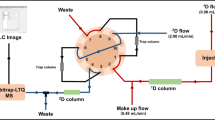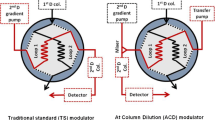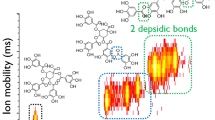Abstract
A method based on stop-flow two-dimensional liquid chromatography coupled with electrospray ionization mass spectrometry (2D LC-ESI MS) was established and applied to analyze triterpenoid saponins from the main root of ginseng. Due to the special structure of triterpenoid saponins (they contain polar sugar side chains and nonpolar aglycones), hydrophilic interaction chromatography (HILIC) and reversed-phase liquid chromatography (RPLC) were used for the two dimensions, respectively. A trap column was used to connect the two dimensions. The dilution effect, which is one of the main shortcomings of traditional comprehensive 2D LC methods, was largely avoided. The peak capacity of this system was 747 and the orthogonality was 56.6 %. Compared with one-dimensional HILIC or RP LC MS analysis, 257 and 185 % more mass spectral peaks (ions with intensities that were higher than 1,000) were obtained from the ginseng main root extracts, and 94 triterpenoid saponins were identified based on MSn information and summarized aglycone structures. Given its good linearity and repeatability, the established method was successfully applied to classify ginsengs of different ages (i.e., years of growth), and 19 triterpenoid saponins were found through statistical analysis to vary in concentration depending on the age of the ginseng.

Process of saponin's analysis using stop-flow 2D LC method







Similar content being viewed by others
References
Hu C, Wei H, Kong H, Bouwman J, Gonzalez-Covarrubias V, van der Heijden R, Reijmers TH, Bao X, Verheij ER, Hankemeier T, Xu G, van der Greef J, Wang M (2011) Linking biological activity with herbal constituents by systems biology-based approaches: effects of Panax ginseng in type 2 diabetic Goto-Kakizaki rats. Mol BioSyst 7(11):3094–3103
Wang W, Zhao YQ, Rayburn ER, Hill DL, Wang H, Zhang RW (2007) In vitro anti-cancer activity and structure–activity relationships of natural products isolated from fruits of Panax ginseng. Cancer Chemother Pharmacol 59(5):589–601
Avato P, Bucci R, Tava A, Vitali C, Rosato A, Bialy Z, Jurzysta M (2006) Antimicrobial activity of saponins from Medicago sp.: structure–activity relationship. Phytother Res 20(6):454–457
Zhu D, Wu L, Li CR, Wang XW, Ma YJ, Zhong ZY, Zhao HB, Cui J, Xun SF, Huang XL, Zhou Z, Wang SQ (2009) Ginsenoside Rg1 protects rat cardiomyocyte from hypoxia/reoxygenation oxidative injury via antioxidant and intracellular calcium homeostasis. J Cell Biochem 108(1):117–124
Vanhaelen-Fastré RJ, Faes ML, Vanhaelen MH (2000) High-performance thin-layer chromatographic determination of six major ginsenosides in Panax ginseng. J Chromatogr A 868(2):269–276
Tian Y, Lu Y, Xie J, Cheng Y, Qi R, Wu Y, Zhang S (2009) Rapid determination of ginsenoside Rg1, Re and Rb1 in ginseng samples by capillary electrophoresis. Anal Methods 1(3):203–207
Cui J-F, Björkhem I, Eneroth P (1997) Gas chromatographic-mass spectrometric determination of 20(S)-protopanaxadiol and 20(S)-protopanaxatriol for study on human urinary excretion of ginsenosides after ingestion of ginseng preparations. J Chromatogr B 689(2):349–355
Guo X, Zhang X, Guo Z, Liu Y, Shen A, Jin G, Liang X (2014) Hydrophilic interaction chromatography for selective separation of isomeric saponins. J Chromatogr A 1325:121–128
Giddings JC (1995) Sample dimensionality: a predictor of order–disorder in component peak distribution in multidimensional separation. J Chromatogr A 703:3–15
Wang Y, Wang J, Yao M, Zhao X, Fritsche J, Schmitt-Kopplin P, Cai Z, Wan D, Lu X, Yang S, Gu J, Haring HU, Schleicher ED, Lehmann R, Xu G (2008) Metabonomics study on the effects of the ginsenoside Rg3 in a beta-cyclodextrin-based formulation on tumor-bearing rats by a fully automatic hydrophilic interaction/reversed-phase column-switching HPLC-ESI-MS approach. Anal Chem 80(12):4680–4688
Donato P, Cacciola F, Sommella E, Fanali C, Dugo L, Dacha M, Campiglia P, Novellino E, Dugo P, Mondello L (2011) Online comprehensive RPLC × RPLC with mass spectrometry detection for the analysis of proteome samples. Anal Chem 83(7):2485–2491
Li Q, Lynen F, Wang J, Li H, Xu G, Sandra P (2012) Comprehensive hydrophilic interaction and ion-pair reversed-phase liquid chromatography for analysis of di- to deca-oligonucleotides. J Chromatogr A 1255:237–243
Kalili KM, Vestner J, Stander MA, de Villiers A (2013) Toward unraveling grape tannin composition: application of online hydrophilic interaction chromatography × reversed-phase liquid chromatography-time-of-flight mass spectrometry for grape seed analysis. Anal Chem 85(19):9107–9115
Wang Y, Lehmann R, Lu X, Zhao X, Xu G (2008) Novel, fully automatic hydrophilic interaction/reversed-phase column-switching high-performance liquid chromatographic system for the complementary analysis of polar and apolar compounds in complex samples. J Chromatogr A 1204(1):28–34
Bankefors J, Nord LI, Kenne L (2010) Multidimensional profiling of components in complex mixtures of natural products for metabolic analysis, proof of concept: application to Quillaja saponins. J Chromatogr B 878(3–4):471–476
Xing Q, Liang T, Shen G, Wang X, Jin Y, Liang X (2012) Comprehensive HILIC × RPLC with mass spectrometry detection for the analysis of saponins in Panax notoginseng. Analyst 137(9):2239–2249
Jeong EK, Cha HJ, Ha YW, Kim YS, Ha IJ, Na YC (2010) Development and optimization of a method for the separation of platycosides in Platycodi radix by comprehensive two-dimensional liquid chromatography with mass spectrometric detection. J Chromatogr A 1217(26):4375–4382
Wang Y, Lu X, Xu G (2008) Development of a comprehensive two-dimensional hydrophilic interaction chromatography/quadrupole time-of-flight mass spectrometry system and its application in separation and identification of saponins from Quillaja saponaria. J Chromatogr A 1181(1–2):51–59
Wang S, Li J, Shi X, Qiao L, Lu X, Xu G (2013) A novel stop-flow two-dimensional liquid chromatography–mass spectrometry method for lipid analysis. J Chromatogr A 1321:65–72
Liang Y, Guan T, Zhou Y, Liu Y, Xing L, Zheng X, Dai C, Du P, Rao T, Zhou L, Yu X, Hao K, Xie L, Wang G (2013) Effect of mobile phase additives on qualitative and quantitative analysis of ginsenosides by liquid chromatography hybrid quadrupole–time of flight mass spectrometry. J Chromatogr A 1297:29–36
Gilar M, Olivova P, Daly AE, Gebler JC (2005) Orthogonality of separation in two-dimensional liquid chromatography. Anal Chem 77(19):6426–6434
Liu Y, Xue X, Guo Z, Xu Q, Zhang F, Liang X (2008) Novel two-dimensional reversed-phase liquid chromatography/hydrophilic interaction chromatography, an excellent orthogonal system for practical analysis. J Chromatogr A 1208(1–2):133–140
Perreault H, Costello CE (1994) Liquid secondary ionization, tandem and matrix-assisted laser desorption/ionization time-of-flight mass spectrometric characterization of glycosphingolipid derivatives. Org Mass Spectrom 29(12):720–735
Kite GC, Howes MJ, Leon CJ, Simmonds MS (2003) Liquid chromatography/mass spectrometry of malonyl-ginsenosides in the authentication of ginseng. Rapid Commun Mass Spectrom 17(3):238–244
Acknowledgments
The study was supported by the National Basic Research Program (nos. 2012CB720801, 2012CB517506) from the State Ministry of Science and Technology of China, the Foundations (nos. 21175132 and 21275141) and the Creative Research Group Project (no. 21321064) from the National Natural Science Foundation of China.
Author information
Authors and Affiliations
Corresponding authors
Additional information
Published in the topical collection Multidimensional Chromatography with guest editors Torsten C. Schmidt, Oliver J. Schmitz, and Thorsten Teutenberg.
Electronic supplementary material
Below is the link to the electronic supplementary material.
ESM 1
(PDF 321 kb)
Rights and permissions
About this article
Cite this article
Wang, S., Qiao, L., Shi, X. et al. On-line stop-flow two-dimensional liquid chromatography–mass spectrometry method for the separation and identification of triterpenoid saponins from ginseng extract. Anal Bioanal Chem 407, 331–341 (2015). https://doi.org/10.1007/s00216-014-8219-4
Received:
Revised:
Accepted:
Published:
Issue Date:
DOI: https://doi.org/10.1007/s00216-014-8219-4




